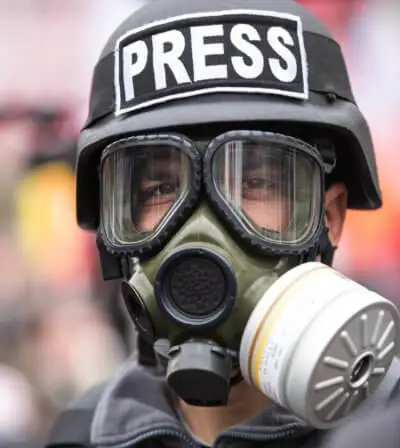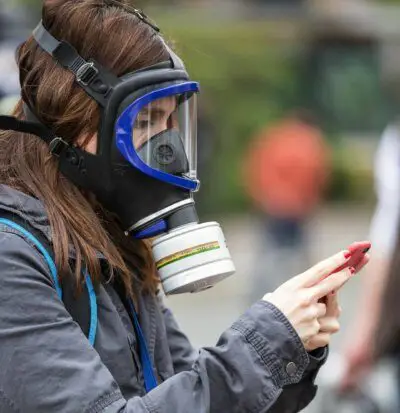In the past, only soldiers needed to worry about needing gas masks. However, with today’s threats, it’s becoming more and more likely that civilians will be exposed to all kinds of hazardous substances.
Gas masks protect against riot control agents from police, the fallout from nuclear attacks, biological warfare agents, toxic smoke from terrorist attacks, and other chemicals. These are all possible reasons that the everyday person may need access to a gas mask.
Do You Need a Gas Mask?
Many people often wonder if they even need a gas mask. It’s a good question that isn’t necessarily cut and dry.
I think you need to get a gas mask if you’re a serious prepper, but only after you have all of your other essentials covered. If you have all the water and food, you think you’ll need, a defensive firearm and ammo, and have added even more water and food, then you’re probably at the point when you should buy masks for your family.
Cheaper surplus masks are great if you’re on a budget.
Of course, if you’re not on a budget and feel like picking up a gas mask now, by all means, go for it. Just know that buying gas masks doesn’t need to be a priority for most people. You may want to prioritize the purchase of a mask if you live in a major city that is likely to face police using riot control agents.
What Makes a Good Gas Mask?
Quality gas masks are relatively inexpensive these days. Even gas masks specifically produced for the public are of high quality and accessible to almost everyone. Military surplus gas masks can be hit-and-miss. Don’t just assume that surplus gas masks are made well or of good quality because other militaries use them.

How to Inspect a Gas Mask
Any gas mask should be inspected as soon as you receive it and annually when it’s in storage. This is especially true for military surplus masks.
To inspect your gas mask, start by looking at the rubber itself. If there are cracks or dry rot, you need to get a new gas mask.
Next, inspect any areas where the rubber meets other types of material. Areas where rubber and metal or rubber and plastic meet are common points of failure. Gently pull at these areas to make sure they are solidly connected and not going to come apart.
Inspect whatever type of facepiece or eye covers your mask has. Check the seams to ensure they are securely attached, and look through them to ensure that they aren’t cloudy and you can see clearly through them. If there are cracks or gaps in the seam, replace the mask. If the facepiece is cloudy, then it’s up to you to decide if it obstructs your vision enough to replace it.
Check your head harness. It should allow you to easily and securely attach the gas mask to your face. If it doesn’t, replace the head harness or replace the mask.
Check every valve the mask has and things like drinking straws and voicemitters. Most gas masks have several one-way valves. These can dry rot, deteriorate, and even be incorrectly installed.
Take special attention when you’re inspecting the valves. Any valves that are stuck or sticky should be replaced. If they stick while the mask is on your face, it can make it so you cannot breathe.
After you’re sure everything is working properly and in good shape, put the mask on and cover the inlet on the filter with your hand. Try to inhale. You should not have any air leaking from the seal around your face or any seam on the mask.
If you hear air leaking into the mask, the seal is the most likely problem. Make sure you don’t have any hair between your face or forehead and the mask, and try to tighten the head harness. If this doesn’t work, your mask is compromised or doesn’t fit your face properly.

What do gas masks protect you from?
A gas mask protects you from particulates and some chemical vapors in the air. This means very small pieces of solid material floating in the air are filtered out, and an activated charcoal layer absorbs chemicals. It does not provide oxygen and will not protect you from environments that do not contain oxygen.
Most preppers will want a gas mask to protect from either riot control agents used by the police and military or from alpha and beta following a nuclear attack or dirty bomb. In my mind, these are the most likely uses for a mask, but that doesn’t mean there aren’t other logical reasons to own a gas mask.
Chemical weapons are one of the main reasons that gas masks exist. It may not be a likely scenario, but they can protect you in the event of a chemical attack.
They can also protect you from a biological attack or even some pandemic!
You must understand that a mask doesn’t make you impervious to chemical, nuclear or biological attacks. Still, it adds an extra layer of protection you otherwise wouldn’t have.
What don’t gas masks protect you from?
As we said before, a mask will not allow you to breathe in an atmosphere that doesn’t contain oxygen. (There are a few special filters that will generate oxygen for a limited time.)
However, that is not the only thing it won’t protect you from.
This should go without saying, but a mask only protects the area it covers and your respiratory system. Your body is still exposed to anything it comes in contact with.
This means that if you come in contact with a chemical agent that can absorb through your skin, you will still suffer the effects of that chemical agent. This is also true if you get contaminated and then remove your mask.
Whatever is on your body may still be able to injure or kill you. If you get contaminated with a toxic substance, you must decontaminate yourself before removing your mask and any protective clothing!
The same is true for nuclear materials. Just because your gas mask says it protects from nuclear contamination doesn’t mean it protects from all types of nuclear particles. It only protects you from alpha and beta particles. All other forms of radiation will still be bombarding your body!
How long can you wear a gas mask?
The length of time that you can spend in a mask depends on several things. How active are you being while in the mask? What is the weather like? Do you have a drinking tube and canteen?
The main thing that prevents you from wearing a gas mask for extended periods is the ability to drink water. If you have a mask with a drinking tube and a canteen that can attach to it, you’ve defeated this. If not, you will be severely limited in the amount of time you spend in a mask.
Activity level and weather also majorly affect how long you can spend in a mask. If you’re running or fighting, you’ll need much more water than someone who is relaxing in a chair in the air conditioning. You can be as active as you want in a mask as long as you’re physically able to keep going and can keep getting clean water.
Some people bring being able to eat, pain, and discomfort-into the equation. Wearing a gas mask is extremely uncomfortable, but comfort doesn’t play a role when trying to survive. You can also go for weeks with no food. Again, comfort doesn’t play a part when trying to survive.
What type of gas mask filter do you need?
A standard NATO 40mm canister is what we recommend. These are common among police and military-issued masks, so you shouldn’t have a problem finding them for sale.
Choosing a mask that uses a different type of canister is fine. Just know that you may have a more difficult time finding replacements.
How often do I need to change my gas mask filter?
People don’t often realize that gas mask filters expire and must be replaced when exposed to chemicals.
Sealed and packaged filters typically claim to last for around five years. This is normally a very conservative timeframe. We suggest using the manufacturer’s suggested shelf life whenever possible. In a real emergency, you may get away with using a filter after its shelf life has expired as long as you understand that you may get less protection than expected.
You should also change your filter after it’s been exposed to chemical agents. This should be accomplished between 8 and 24 hours after exposure. Be aware that certain chemical agents can cause a filter to stop being effective in as little as 30 minutes.
When a filter is exposed to particulate matter, it doesn’t need to be changed as often. As long as the filter still allows you to breathe through it without much restriction, you should be good to use the filter for up to 30 days.
Any time a filter is damaged, you should replace it. Dents and dings on the outside could compromise the filter inside.

